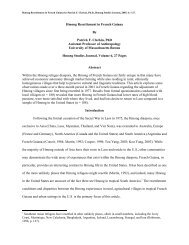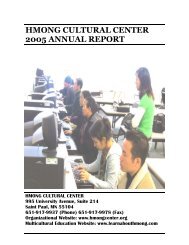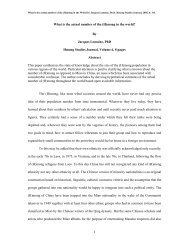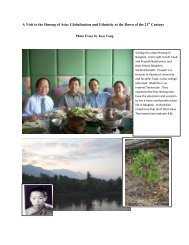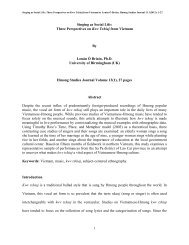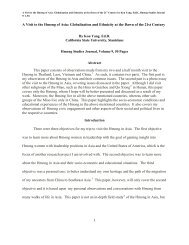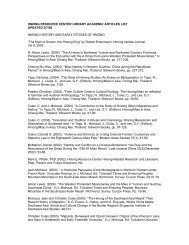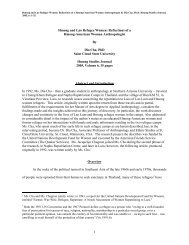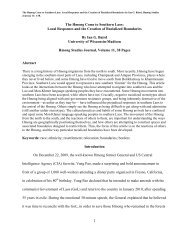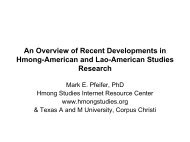Research Notes from the Field - Hmong Studies Internet Resource ...
Research Notes from the Field - Hmong Studies Internet Resource ...
Research Notes from the Field - Hmong Studies Internet Resource ...
Create successful ePaper yourself
Turn your PDF publications into a flip-book with our unique Google optimized e-Paper software.
<strong>Research</strong> <strong>Notes</strong> <strong>from</strong> <strong>the</strong> <strong>Field</strong>:Tracing <strong>the</strong> Path of <strong>the</strong> Ancestors – A Visit to <strong>the</strong> <strong>Hmong</strong> in China by Kou Yang, EdD,<br />
<strong>Hmong</strong> <strong>Studies</strong> Journal, 2005, 6: 1-38.<br />
o<strong>the</strong>r scholars and leaders <strong>the</strong> author met in Guizhou also referred to Zhang Shiumei as <strong>the</strong> leader of <strong>the</strong><br />
rebellion of <strong>the</strong> middle of <strong>the</strong> nineteenth century. Some historians, however, question <strong>the</strong> account of Zhang<br />
Shiumei being <strong>the</strong> supreme leader of <strong>the</strong> mentioned rebellion. Jenks (1994), for example, suggests that <strong>the</strong><br />
portrayal of Zhang Shiumei as <strong>the</strong> supreme leader of <strong>the</strong> “Miao Rebellion,” is political in nature, supporting<br />
<strong>the</strong> People’s Republic of China by making Zhang Shiumei a hero of Miao’s struggle against <strong>the</strong> oppression of<br />
<strong>the</strong> Qing Dynasty. Jenks also states that <strong>the</strong> naming of Zhang Shiumei as <strong>the</strong> supreme leader of <strong>the</strong> rebellion<br />
plays down <strong>the</strong> roles of o<strong>the</strong>r leaders, such as Gao He, who was referred to in historical documents as one of<br />
<strong>the</strong> two “great kings.” The o<strong>the</strong>r great king was Jiu Song – one of <strong>the</strong> leaders of <strong>the</strong> rebellion.<br />
According to Jenks, Gao He, who was captured in 1872 near Leigong Mountain, was <strong>the</strong> last leader<br />
to be captured. He lists <strong>the</strong> Miao leaders of <strong>the</strong> rebellion as Zhang Shiumei, Gao He, Bao Dadu, Jin Gan’gan,<br />
Jin Dawu, and Jiu Dabai. Jenks sums up his description of <strong>the</strong> Miao leaders of <strong>the</strong> rebellion writing “All but<br />
<strong>the</strong> last, who was killed in action in April 1872, were captured and executed by <strong>the</strong> government” (1994:159).<br />
Although many leaders of <strong>the</strong> rebellion were Miao, Jenks argues that <strong>the</strong> label “Miao” rebellion against Han<br />
rulers is not a proper depiction of <strong>the</strong> Miao. He states that <strong>the</strong> Han rulers created <strong>the</strong> label to use <strong>the</strong> Miao as<br />
a scapegoat. The rebellion, he writes, included many factions, with leaders and supporters <strong>from</strong> many ethnic<br />
groups, including <strong>the</strong> Miao and <strong>the</strong> Han.<br />
Shidong: After having lunch in Taijing and a brief tour of <strong>the</strong> Zhang Shiumei statue, <strong>the</strong> group left<br />
<strong>the</strong> town heading to Shidong and <strong>the</strong>n to Kaili. On <strong>the</strong> way to Shidong, <strong>the</strong> group passed through <strong>the</strong> rough<br />
landscape of Guizhou and went up and down along <strong>the</strong> hills and valleys of this part of Guizhou, seeing <strong>the</strong><br />
villages of many ethnic minorities and <strong>the</strong>ir terrace paddy fields. Despite <strong>the</strong> inhospitable terrains and<br />
climates, many parts of <strong>the</strong> landscape were beautiful and breathtaking. In <strong>the</strong> afternoon, <strong>the</strong> group reached <strong>the</strong><br />
town of Shidong, which was located on <strong>the</strong> banks of <strong>the</strong> Wuyang River. This town is famous for making<br />
Miao silver ornaments. The group stopped and bought many Miao silver ornaments and toured <strong>the</strong>ir factories.<br />
Unlike in o<strong>the</strong>r mountain towns, many families in this town owned <strong>the</strong> boats <strong>the</strong>y used for <strong>the</strong> boat festival.<br />
After visiting Shidong, <strong>the</strong> group took a road that was under construction to Kaili. Because of <strong>the</strong> condition of<br />
<strong>the</strong> road, it took many hours for <strong>the</strong> group to reach Kaili, <strong>the</strong> Capital of Qiangdongnan Miao and Dong<br />
Autonomous Prefecture.<br />
16




